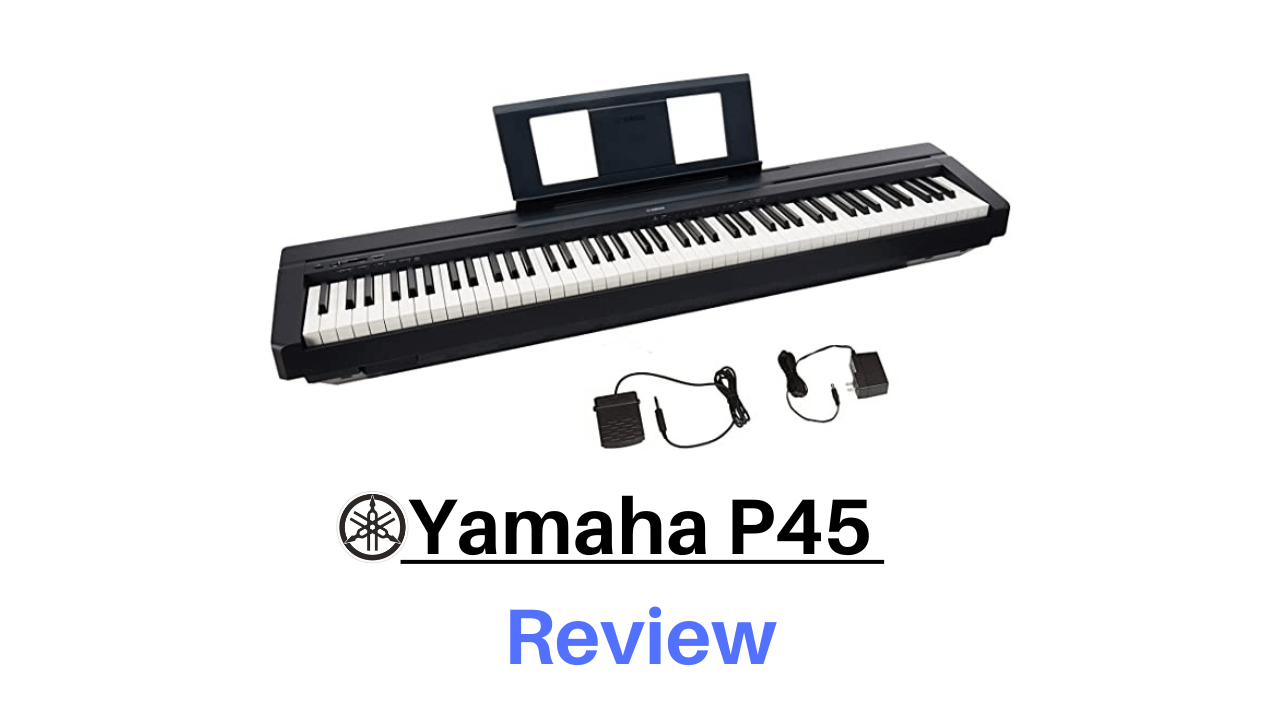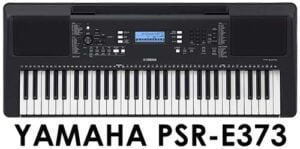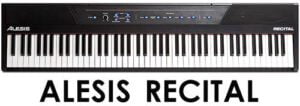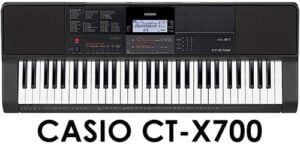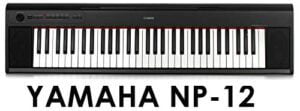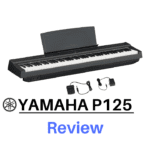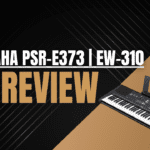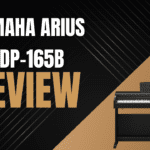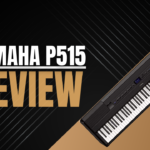As a pianist and music teacher, I recently had the opportunity to extensively test and review the Yamaha P45 – an entry-level 88-key digital piano aimed at beginners and intermediate players. After spending several weeks evaluating its key features, sound quality, and overall usability, I’m ready to share my detailed thoughts in this Yamaha P45 review.
Yamaha P-45 Specs
- Fully weighted 88-key keyboard with matte black keytops
- Hammer with Grades
- Touch Sensitivity with Standard Action (Hard, Medium, Soft, Fixed)
- AWM stereo sampling is used for audio.
- Polyphonic polyphony of 64 notes
- 10 different instrument sounds (2 pianos)
- 10 pre-programmed piano songs + 10 demo songs
- Modes include Duo, Dual Metronome, Transpose, and Fine-tuning.
- Speaker power: 6W + 6W (12cm x 2)
- USB to Host, Headphone jack, Sustain Pedal jack Dimensions: 1,326 x 295 x 154 mm (52.2″ x 11.6″ x 6.0″)
11.5 kg (25 lbs. 6 oz) (25 lbs. 6 oz.)
Overview of the Yamaha P45 Digital Piano

The P45 is Yamaha’s most affordable 88-key digital piano. As part of Yamaha’s popular P-series, it’s designed to provide realistic piano sound and feel in a lightweight, portable package. Some key features include:
- 88 graded hammer action keys with matte black keytops
- Advanced Wave Memory stereo sampling sound engine
- 64-note polyphony
- 10 high-quality instrument voices including Yamaha CFIIIS concert grand piano
- Dual mode for layering two voices
- 4 types of reverb plus chorus effect
- USB MIDI connection for use with computers and mobile devices
- Optional sustain pedal sold separately
- Weighs only 25 lbs for easy portability
With an MSRP of $499, the P45 delivers many features of Yamaha’s more expensive digital pianos at a fraction of the cost. It’s aimed at beginners, students, and intermediate players who want realistic piano sound and feel without breaking the bank.
Unboxing and Setup of the Yamaha P45
Upon unboxing the Yamaha P45, I found the included contents to be simple but functional. The package contains the keyboard itself, a power adapter, and a sustain pedal.
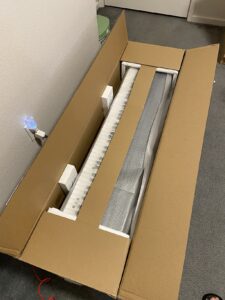
The keyboard has a slim, lightweight build made of plastic. It looks nice with its matte black finish and minimalist design. The 88 keys have a matte texture which absorbs sweat and oils from your fingers.
Setup is quick and easy. Simply plug in the power adapter, connect headphones or speakers to the 1/4″ stereo jacks, and you’re ready to start playing. The P45 can also connect to a Mac or PC via its USB MIDI port to use music software or record performances. An optional LP-5A triple pedal unit can be purchased separately for added functionality.
Weighing in at just 25 lbs, the P45 is quite portable and can be easily moved between rooms or taken to gigs. The slim profile takes up little space, making it ideal for small apartments or studios.
Let’s take a closer look at this wonderful instrument.
Playing Experience of the Yamaha P45
Now, let’s get into the meat of this P45 review – how does it feel to play?
Yamaha utilizes its GHS (Graded Hammer Standard) weighted action on the P45. This gives the keys a pleasing piano-like resistance with the lower notes feeling heavier than the higher ones, just like an acoustic piano.
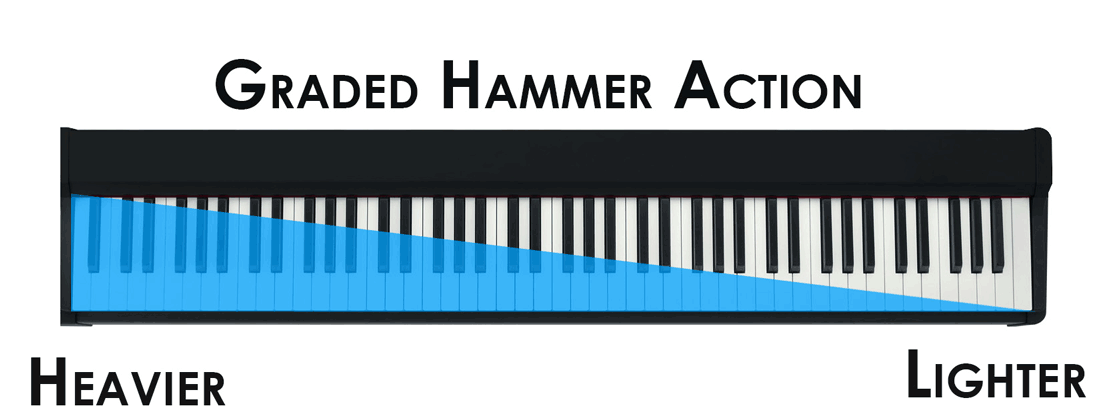
The key tops have a matte texture which absorbs moisture and gives a smooth feel during fast passages and repetitions. The action is relatively quiet as you play with minimal mechanical noise.
While not quite as realistic as more expensive Yamaha actions like the GH and NWX, the GHS action provides a satisfying piano-playing experience at this price point. The keys have a bit of a “plastic” feel compared with premium actions, but overall they respond well to nuanced playing dynamics.
The 64-note polyphony is decent for a digital piano in this price range. I was able to play complex classical pieces without experiencing note dropout. More advanced players may want higher polyphony, but beginners won’t run into limitations.
Sound Quality of the Yamaha P45
When it comes to sound, the Yamaha P45 delivers impressive realism for the price thanks to Yamaha’s acclaimed Advanced Wave Memory sampling. The stereo grand piano sample features clear resonance, warmth, and dynamic range.
Through the built-in speakers, the piano tones sound vibrant and natural. There’s a sense of airiness and movement to the sound. The low notes have pleasing resonance while the highs shimmer nicely. Yamaha’s CFIIIS concert grand sample comes through nicely.
Plugging headphones into the 1⁄4” jacks provides an even more detailed listening experience. Subtleties like key-off samples, pedal resonance, and intricate reverb tails become apparent.
The P45 features 9 other instrument sounds including electric pianos, organs, strings, and bass. While not as realistic as the piano sounds, they help provide some variety for playing different musical genres.
There are 4 reverb types and a chorus effect. Reverb helps give a sense of playing in various environments from a small room to a concert hall. Chorus adds fullness which is nice for electric piano tones.
Features of the Yamaha P45
Despite its budget price point, the Yamaha P45 packs an impressive range of features:
- Dual Mode – This allows you to layer two instrument voices together, such as piano and strings. The volume balance is adjustable. Dual mode expands the P45’s sonic capabilities for more diverse musical parts.
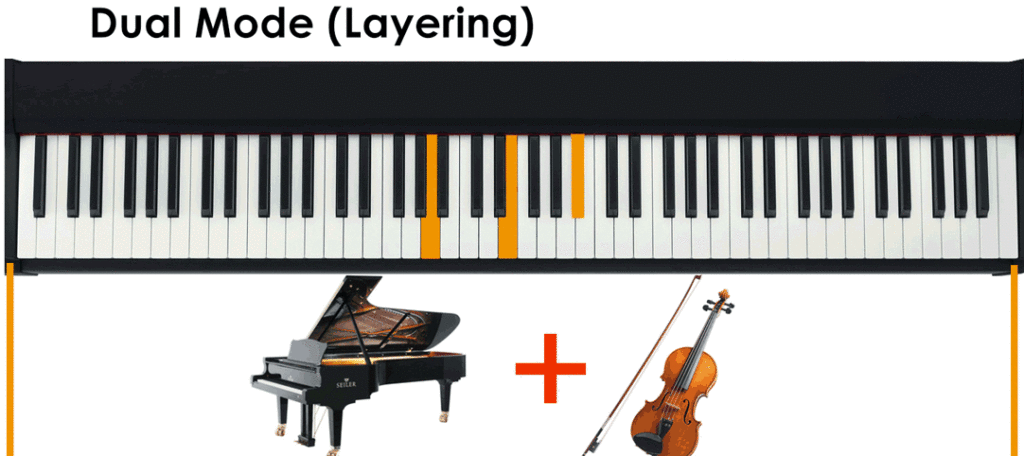
- Split Mode – This lets you split the keyboard into two sections with each playing a different voice. For example, bass in the left hand and piano in the right. Great for teacher-student lessons or solo performances.
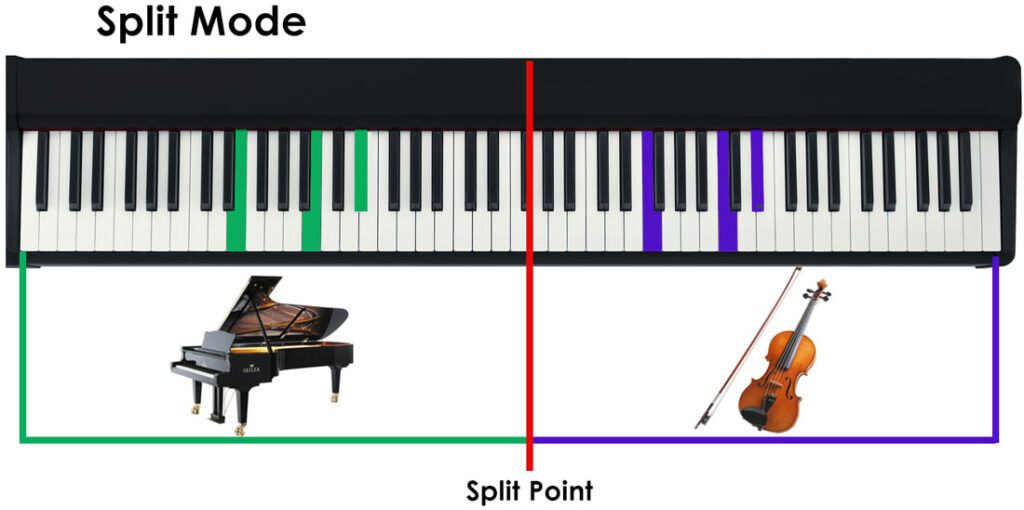
- Transpose – Electronically shifts the pitch of the P45 up or down by up to one octave. Useful for adapting to different vocal ranges or tuning instruments.
- Metronome – The built-in metronome covers a wide tempo range from 20-280 BPM. It’s great for practicing with accurate rhythm and timekeeping. You can adjust the time signature, tempo, and volume.
- Sound Boost – This instantly makes the piano sound fuller and more powerful. It’s like having a virtual amp to give your playing more dynamic presence.
- MIDI – The P45 has USB MIDI connectivity for interfacing with computers and mobile devices. Opens up possibilities for music production, composition, and controlling synthesizers.
- Touch Sensitivity – The keyboard responds dynamically to your playing touch from soft to hard. This allows you to easily control expression and bring out tonal nuances.
Pros of the Yamaha P45
During my time with the Yamaha P45, I really came to appreciate the many benefits it provides for the price:
- Realistic piano sound – Yamaha’s excellent AWM sampling delivers rich, natural piano tones through the onboard speakers and headphones.
- Weighted 88-key action – The GHS weighted action feels satisfying for beginner to intermediate players. Enough resistance without being overly heavy.
- Portability – Weighing just 25 lbs, the P45 is easy to move around and transport to lessons or gigs. The small footprint fits well in tight spaces.
- Good selection of features – Dual mode, split mode, transpose, metronome, and other features offer capabilities above its price class.
- USB MIDI connectivity – For music production and composition using DAW software or controlling external MIDI gear.
- Affordable price – At around $500, the P45 delivers great bang-for-your-buck. A noticeable step up from non-weighted keyboards.
- Quality construction – The P45 feels solidly built. The keys and buttons have a responsive, durable feel during intense practice sessions.
Cons of the Yamaha P45
While I found the Yamaha P45 to be an excellent value digital piano, there are a few downsides worth mentioning:
- Keys not weighted to the top – Only the mechanism is weighted, not the key tops. Can feel unbalanced when playing softly.
- No LCD display – Some competing models in this price range have LCD screens for displaying settings. The P45 lacks a display.
- Basic polyphony – 64 notes should suffice for most beginners, but more advanced players may want higher polyphony for complex pieces.
- No built-in recording – You’ll need to connect to a computer via USB MIDI to record your playing. Some competitors have onboard recording capability.
- Older sound engine – The Advanced Wave Memory engine dates back over a decade. Some newer competing models offer improved sampling fidelity.
- Single sustain pedal – An optional 3-pedal unit would be nice for techniques like sostenuto. You’ll need to purchase the LP-5A unit separately.
- No Bluetooth – The P45 only has wired USB MIDI. Some players may prefer wireless Bluetooth connectivity.
Alternatives to Consider
The Yamaha P45 competes with other affordable 88-key digital pianos like:
| Feature | Yamaha P45 | Casio PX-160 | Roland FP-10 |
|---|---|---|---|
| Keys | 88 weighted keys with GHS action | 88 weighted keys with Tri-sensor Scaled Hammer Action | 88 weighted keys with PHA-4 Standard action |
| Polyphony | 64 notes | 128 notes | 96 notes |
| Sounds | 10 voices | 18 voices | 15 voices |
| Effects | 4 reverb types, chorus | 4 reverb types, chorus, brilliance | Ambience, brilliance |
| Display | None | LCD display | LCD display |
| Speakers | 12cm x 2 | 8cm x 2 | 12cm x 2 |
| Connectivity | USB MIDI, sustain pedal jack, headphone jacks | USB MIDI, sustain pedal jack, headphone jacks, line out jacks, Bluetooth | USB MIDI, sustain pedal jack, headphone jacks, line out jacks, Bluetooth |
| Weight | 25 lbs | 26 lbs | 28 lbs |
The Casio PX-160 is a close competitor to the Yamaha P45 in the same price range. It offers some advantages over the P45:
- More polyphony at 128 notes vs 64 notes on the P45 for more complex pieces
- LCD display for easier navigation of settings
- Bluetooth connectivity for wireless pairing with devices
- Line out jacks for connecting external speakers
However, the P45 has Yamaha’s renowned piano sound and feel. The GHS-weighted action is very realistic. The AWM stereo sampling provides rich grand piano tones. So the P45 may have an edge in terms of piano realism. But the PX-160 is worth considering if you want more features.
The Roland FP-10 costs a bit more than the P45 but provides some nice upgrades:
- Better PHA-4 Standard key action with escapement
- Improved SuperNATURAL piano sound engine
- Twice the polyphony at 96 notes
- Bluetooth wireless connectivity
- Line out jacks for external speakers
So for about $100-150 more than the P45, the FP-10 gives you enhanced action, sound, and features. The key feel is more realistic and the piano tones more nuanced. It’s a good step up from the P45.
Who is the Yamaha P45 Best Suited For?
Based on my time with this digital piano, I would recommend the Yamaha P45 for:
- Beginners – The weighted keys, piano sounds, and approachable price point make the P45 a great first piano for starting lessons. Gives a solid foundation before upgrading.
- Students – An affordable option for school music labs or at-home practice when an acoustic piano is not feasible. Portable for transporting to lessons.
- Intermediate players – Provides satisfying piano feel and sound for developing technique beyond a cheap keyboard. Good supplementary instrument.
- Gigging musicians – Lightweight and portable for moving to performances. The P45 can readily fit into a car even with limited space.
- Small spaces – With its compact footprint, the P45 is ideal for using in tight apartments, dorm rooms, and studios with limited area.
- Budget-minded buyers – At around $500, the P45 is a great value for getting realistic piano action and sound without excessive cost.
The P45 is likely not the best choice for more advanced pianists who require extremely realistic actions and piano sampling. But for everyone else under that level, it’s an excellent digital piano for the money.
Final Verdict in this Yamaha P45 Review
Yamaha P-45 vs P-71: Amazon sells a special version of the Yamaha P-45 digital piano and names it the Yamaha P-71. The P-71 and P-45 keyboards are the same. The only thing that may be different is their price.
After thoroughly evaluating the Yamaha P45 digital piano, I can confidently recommend it as a great entry-level instrument for beginner to intermediate players.
The GHS weighted keyboard action provides a satisfying piano feel. Yamaha’s AWM stereo sampling delivers rich, natural piano tones. And the portable design with useful features like dual mode, transpose, metronome, and USB MIDI make the P45 a versatile package.
There are a few limitations like basic 64-note polyphony, lack of LCD display, and no Bluetooth connectivity. However, given the affordable price point, the P45 significantly outperforms non-weighted keyboards. It’s a noticeable step up in realism for not much more money.
Overall, the Yamaha P45 earns a rating of 4 out of 5 stars in my review. It’s an excellent digital piano for starting lessons or upgrading from a cheap keyboard. The sound and feel provide a solid foundation that can last many years before needing to upgrade.
Whether you’re a student, hobbyist, or gigging musician, the P45 delivers quality Yamaha sound and performance at an accessible price point. It’s absolutely worth considering for your home or stage piano needs.
FAQs
Q: What is the Yamaha P45?
A: The Yamaha P45 is a digital piano that is designed to simulate the sound and feel of a real piano.
Q: What are the key features of the Yamaha P45?
A: The key features of the Yamaha P45 include its fully weighted keys, which mimic the feel of playing a real piano, and its authentic grand piano sound.
Q: Is the Yamaha P45 a portable piano?
A: Yes, the Yamaha P45 is a portable digital piano, making it easy to transport and play wherever you go.
Q: What is the difference between the Yamaha P45 and the Yamaha P71?
A: The Yamaha P45 and Yamaha P71 are essentially the same piano, with the P71 being an Amazon exclusive model. The only difference is in the model number.
Q: Is the Yamaha P45 suitable for beginners?
A: Yes, the Yamaha P45 is often recommended as a beginner piano due to its affordable price, realistic feel, and high-quality sound.
Q: Does the Yamaha P45 have a grand piano sound?
A: Yes, the Yamaha P45 features a grand piano sound that is designed to closely resemble the sound of a real grand piano.
Q: Can the Yamaha P45 be used for piano lessons?
A: Yes, the Yamaha P45 is a popular choice for piano teachers and students, as it offers a realistic piano playing experience.
Q: What is the difference between the Yamaha P45 and the Yamaha P125?
A: The Yamaha P45 and Yamaha P125 are both entry-level digital pianos, but the P125 offers additional features and a higher price point.

